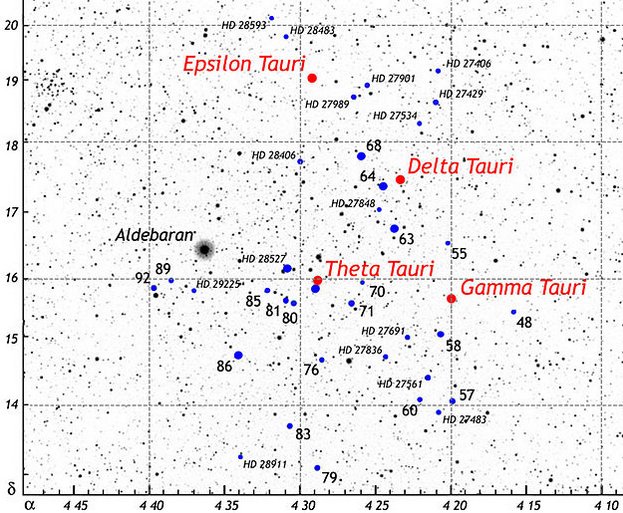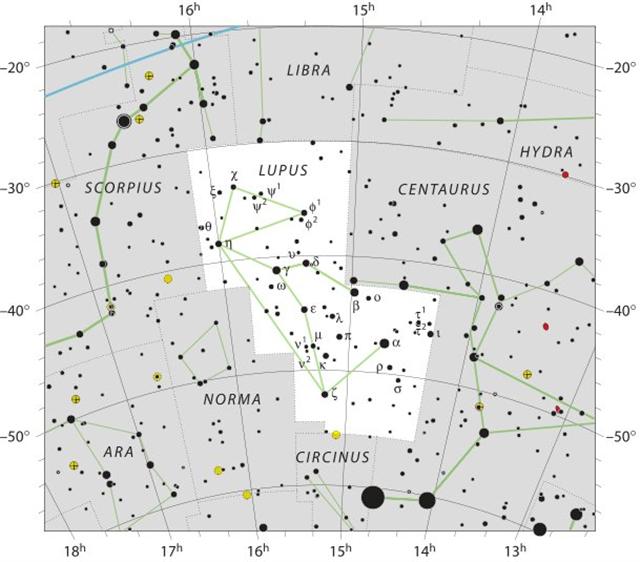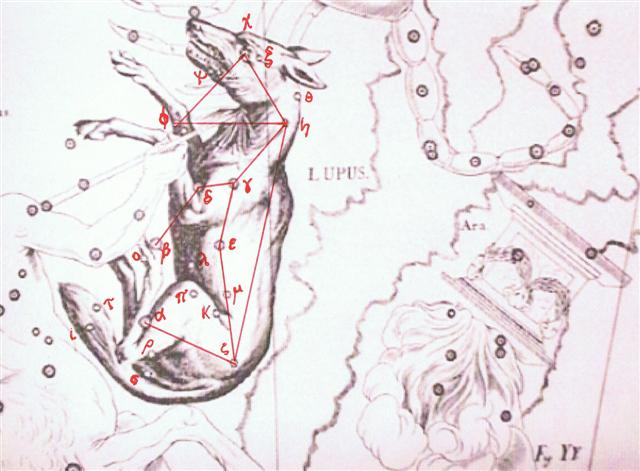The names Ohiro
and Oata
were used at the
beginning of a new
month:
|
12 |
Auva
13 |
Simak
1 |
2 |
3 |
4
(174) |
|
November
1 |
2 |
3 |
4 |
5 |
6
(310) |
 |
 |
 |
 |
 |
 |
|
Ca8-26
(225) |
Ca8-27 |
Ca8-28 |
Ca8-29 |
Ca9-1 |
Ca9-2
(230) |
|
- |
- |
- |
- |
Ohiro |
Oata |
|
te
ahi
ki
te
rima
aueue
- te
ika |
tupu
te
ure
o te
henua |
erua
kiore |
Te
marama
erua |
|
Kochab
(225.0) |
Ke
Kwan
(226.3),
Ke
Kwan
(226.4) |
Zuben
Elakribi
(226.8),
Nekkar
(227.3) |
15h
(228.3) |
λ
Lupi
(228.9) |
κ
Lupi
(229.7),
ζ
Lupi
(229.8) |
|
π
Lupi
(227.9),
Zuben
Hakrabim
(228.3) |
|
3 |
May
4 |
5
(125) |
6 |
7 |
8 |
|
2 |
Alrescha
3 |
4
(354) |
5 |
6 |
7 |
|
no
star
listed |
Acamar
(43.6) |
Menkar
(44.7) |
3h
(45.7) |
no
star
listed |
Botein
(46.9) |
|
Algol
(45.9),
Misam
(46.2) |
|
Hiro
1. A
deity
invoked
when
praying
for
rain
(meaning
uncertain).
2.
To
twine
tree
fibres
(hauhau,
mahute)
into
strings
or
ropes.
Ohirohiro,
waterspout
(more
exactly
pú
ohirohiro),
a
column
of
water
which
rises
spinning
on
itself.
Vanaga.
To
spin,
to
twist.
P
Mgv.:
hiro,
iro,
to
make
a
cord
or
line
in
the
native
manner
by
twisting
on
the
thigh.
Mq.:
fió,
hió,
to
spin,
to
twist,
to
twine.
Ta.:
hiro,
to
twist.
This
differs
essentially
from
the
in-and-out
movement
involved
in
hiri
2,
for
here
the
movement
is
that
of
rolling
on
the
axis
of
length,
the
result
is
that
of
spinning.
Starting
with
the
coir
fiber,
the
first
operation
is
to
roll
(hiro)
by
the
palm
of
the
hand
upon
the
thigh,
which
lies
coveniently
exposed
in
the
crosslegged
sedentary
posture,
two
or
three
threads
into
a
cord;
next
to
plait
(hiri)
three
or
other
odd
number
of
such
cords
into
sennit.
Hirohiro,
to
mix,
to
blend,
to
dissolve,
to
infuse,
to
inject,
to
season,
to
streak
with
several
colors;
hirohiro
ei
paatai,
to
salt.
Hirohiroa,
to
mingle;
hirohiroa
ei
vai,
diluted
with
water.
Churchill.
Ta.:
Hiro,
to
exaggerate.
Ha.:
hilohilo,
to
lengthen
a
speech
by
mentioning
little
circumstances,
to
make
nice
oratorial
language.
Churchill.
Whiro
'Steals-off-and-hides';
also
[in
addition
to
the
name
of
Mercury]
the
universal
name
for
the
'dark
of
the
Moon'
or
the
first
day
of
the
lunar
month;
also
the
deity
of
sneak
thieves
and
rascals.
Makemson. |
|
Koa
1.
Rori
te
koa
hogihogi,
to
follow
a
scent.
2.
Joy.
Koakoa,
joy,
content,
happiness,
gay,
satisfaction,
hilarity,
mirth,
to
leap
for
joy,
to
please,
to
fondle,
dear;
ariga
koakoa,
good-humored;
hakakoakoa,
to
rejoice,
to
leap
for
joy.
P
Pau.:
koa,
contented,
pleased;
koakoa,
joy.
Mgv.:
koakoa,
rejoicing,
joy,
mirth,
to
be
content,
satisfied;
koa,
to
mourn.
Ta.:
oaóa,
joy,
gladness.
Churchill.
Pau.:
Koari,
to
languish,
to
fade.
Mgv.:
koari,
half-cooked.
Mq.:
koaí,
rotten,
insufficiently
cooked.
Koata,
a
mesh.
Ta.:
oata,
hole
in
coconuts,
etc.
Mq.:
oata,
crevice.
Churchill.
Mgv.:
Koai,
a
plant.
Ta.:
oai,
the
wild
indigo.
Ma.:
koai,
a
plant.
Akakoana-kohatu,
to
make
a
small
shapeless
hole.
Ma.:
kohatu,
stone.
Koata,
light
of
the
moon
shining
before
the
moon
rises.
Ha.:
oaka,
a
glimpse
of
light.
Churchill. |
Although
these names
in the lunar
calendar
must have
been known
to Metoro he
did not use
them. Indeed
he used none
of the names
in the lunar
calendar at
the glyphs
in the C calendar.
Perhaps
he thought
they would lead
the thoughts
of Bishop
Jaussen in
the wrong
direction.
Perhaps the
Ohiro
and Oata
nights (glyphs
229-230 in the C
text) were primarily
meant to illustrate
another
beginning.
This structure
for the beginning was
in
principle the same
as that in the
G text, because
there hanau
(birth) glyphs were
used for the week
from December 31 and
then followed a pair
of days with ordinal
numbers 229-230
before the tablet
had to be turned
around:
 |
 |
 |
 |
 |
| Ga8-17 |
Ga8-18 (222) |
Ga8-19 |
Ga8-20 |
Ga8-21 |
| λ Cor. Austr. (283.6), Double Double (283.7), ζ Lyrae (283.8), φ Sagittarii (284.0) |
μ Cor. Austr. (284.6), η Cor. Austr., θ Pavonis (284.8), Sheliak, ν Lyrae (285.1) |
λ Pavonis (285.7), Ain al Rami (286.2), δ Lyrae (286.3) |
κ Pavonis (286.5), Alya (286.6), ξ Sagittarii (287.1), ω Pavonis (287.3), ε Cor. Austr., Sulaphat (287.4) |
λ Lyrae (287.7), Ascella (287.9), Nunki (288.4) |
| December 30 |
31 (364 + 1) |
January 1 |
2 |
3 |
| 6 |
7 |
8 |
Qalb al Akraab 9 |
Shaula 1 (232) |
 |
 |
 |
 |
 |
| Ga8-22 |
Ga8-23 (*290) |
Ga8-24 |
Ga8-25 (*292) |
Ga8-26 (230) |
| ζ Cor. Austr. (288.5), Manubrium (288.8), γ Cor. Austr. (289.3), τ Sagittarii (289.4) |
ι Lyrae (289.5), δ Cor. Austr. (289.8), Al Baldah, Alphekka Meridiana (290.1), β Cor. Austr. (290.2) |
Aladfar (291.1) |
Nodus II (291.5), ψ Sagittarii (291.6), θ Lyrae (291.8) |
Arkab Prior (293.0), Arkab Posterior, Alrami (293.2) |
| 19h (289.2) |
January 5 |
6 |
7 (372) |
8 |
| Shaula 2 |
3 |
4 |
5 (236) |
6 |
The
dates,
however,
are
seemingly
in G coordinated
with the
Gregorian
calendar,
which
could
explain
why the
text on
side a
did not
begin
with
March 21
but
instead had
to begin
229 days
earlier
than
January
8.
373
(January
8) -
229
(Ca8-25) =
144 (=
12 *
12) =
May 24:
|
















